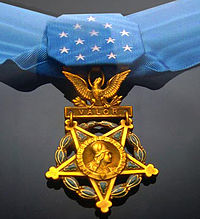Nelson V. Brittin
Nelson V. Brittin | |
|---|---|
 Medal of Honor recipient | |
| Born | October 31, 1920 Audubon, New Jersey |
| Died | March 7, 1951 (aged 30) near Yonggong-ni, Korea |
| Place of burial | |
| Allegiance | United States of America |
| Service/ | United States Army |
| Years of service | 1942–1951 |
| Rank | Sergeant First Class |
| Unit | Company I, 19th Infantry Regiment |
| Battles/wars | World War II Korean War † |
| Awards | Medal of Honor Purple Heart Combat Infantryman Badge |
Nelson Vogel Brittin (October 31, 1920 – March 7, 1951) was an American combat soldier who was killed in action during the Korean War. He was posthumously awarded the Medal of Honor for his actions in Yonggong-ni, Korea, on March 7, 1951.
Brittin graduated from Audubon High School in Audubon, New Jersey in 1939 and joined the United States Army in Audubon on July 7, 1942.[1] He is buried in Beverly National Cemetery in Beverly, New Jersey.[2]
Awards and decorations[edit]
Brittin's military awards include:

| |||||
| Badge | Combat Infantryman Badge with Star (denoting 2nd award) | |||||||||||
|---|---|---|---|---|---|---|---|---|---|---|---|---|
| 1st row | Medal of Honor | Purple Heart | ||||||||||
| 2nd row | Army Good Conduct Medal | World War II Victory Medal | National Defense Service Medal | |||||||||
| 3rd row | Korean Service Medal with 1 Campaign star |
United Nations Korea Medal | Korean War Service Medal | |||||||||
Medal of Honor[edit]

The President of the United States of America, in the name of Congress, takes pride in presenting the MEDAL OF HONOR (Posthumously) to
UNITED STATES ARMY
Citation:
For conspicuous gallantry and intrepidity above and beyond the call of duty while serving with Company I, 3d Battalion, 19th Infantry Regiment, 24th Infantry Division, in action against enemy aggressor forces at Yonggong-ni, Korea on 7 March 1951. Volunteering to lead his squad up a hill, with meager cover against murderous fire from the enemy, Sergeant First Class BRITTIN ordered his squad to give him support and, in the face of withering fire and bursting shells, he tossed a grenade at the nearest enemy position. On returning to his squad, he was knocked down and wounded by an enemy grenade. Refusing medical attention, he replenished his supply of grenades and returned, hurling grenades into hostile positions and shooting the enemy as they fled. When his weapon jammed, he leaped without hesitation into a foxhole and killed the occupants with his bayonet and the butt of his rifle. He continued to wipe out foxholes and, noting that his squad had been pinned down, he rushed to the rear of a machinegun position, threw a grenade into the nest, and ran around to its front, where he killed all three occupants with his rifle. Less than 100 yards up the hill, his squad again came under vicious fire from another camouflaged, sandbagged, machinegun nest well-flanked by supporting riflemen. Sergeant First Class BRITTIN again charged this new position in an aggressive endeavor to silence this remaining obstacle and ran direct into a burst of automatic fire which killed him instantly. In his sustained and driving action, he had killed 20 enemy soldiers and destroyed four automatic weapons. The conspicuous courage, consummate valor, and noble self-sacrifice displayed by Sergeant First Class BRITTIN enabled his inspired company to attain its objective and reflect the highest glory on himself and the heroic traditions of the military service.[3]
See also[edit]
References[edit]
- ^ WWII Army Enlistment Records
- ^ Find a Grave: Nelson Vogel Brittin
- ^ "Valor awards for Nelson Vogel Brittin". Hall of Valor. United States Army Center of Military History. June 8, 2009. Retrieved 2011-12-19.
- ""NELSON V. BRITTIN" entry". Medal of Honor recipients: Korean War. United States Army Center of Military History. June 8, 2009. Archived from the original on 2009-03-10. Retrieved 2007-12-30.
 This article incorporates public domain material from websites or documents of the United States Army Center of Military History.
This article incorporates public domain material from websites or documents of the United States Army Center of Military History.
- 1920 births
- 1951 deaths
- United States Army Medal of Honor recipients
- American military personnel killed in the Korean War
- Audubon High School (New Jersey) alumni
- People from Audubon, New Jersey
- United States Army non-commissioned officers
- Korean War recipients of the Medal of Honor
- Burials at Beverly National Cemetery
- United States Army personnel of World War II
- United States Army personnel of the Korean War
